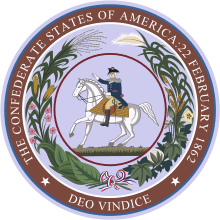Robert Jemison Jr.
Robert Jemison Jr. (September 17, 1802 – October 16, 1871) was an American politician, entrepreneur and slave owner who served as a Confederate States Senator from Alabama from 1863 to 1865. He also served in the two houses of the Alabama Legislature from 1837 until 1863.
Robert Jemison Jr. | |
|---|---|
| Confederate States Senator from Alabama | |
| In office December 28, 1863 – May 10, 1865 | |
| Preceded by | William Yancey |
| Succeeded by | Constituency abolished |
| Personal details | |
| Born | September 17, 1802 Lincoln County, Georgia, U.S. |
| Died | October 16, 1871 (aged 69) Tuscaloosa, Alabama, U.S. |
| Political party | Union Whig, Democratic |
Early years
Jemison was born in Lincoln County, Georgia, near Augusta, Georgia, to William and Sarah (Mims) Jemison. He was educated there at Mount Zion Academy, where he was a classmate of Dixon Hall Lewis, and attended the University of Georgia. His father, William Jemison, was a slaveholder and landowner of at least four large-scale properties. Robert Jemison Jr. used the Jr. behind his name to distinguish himself from his grandfather, also named Robert. In 1826, Jemison moved with his father's family to Pickens County, Alabama, where he was a planter until 1836, when he moved to Tuscaloosa, Alabama.[1]
Career
Jemison served in the Alabama state legislature, initially in the Senate and then in the House, from 1840-1851. He returned to the Senate from 1851-1863. In 1861, he was a Delegate to the Convention and voted against the Ordinance of Secession.[1] He was elected unanimously to be President of the Alabama Senate in 1863; soon after, he was elected to the Confederate States Senate, replacing William Lowndes Yancey, who had died of a kidney ailment.
Jemison owned multiple businesses. A primary source of capital was his plantations. His papers show that he owned 120 slaves in 1851, including 44 children under the age of 10.[2] He owned six plantations in western Alabama, totaling 10,000 acres (4,000 ha). In 1858, he attempted to sell the plantations, 70 slaves and other land in Tuscaloosa, including another residence, a livery stable and the Indian Queen Hotel.[3] Jemison's other ventures included a stagecoach line, toll roads, toll bridges, grist mills, sawmills, turnpikes, stables, a hotel, and plank roads. His largest enterprise was a 4,000-acre (1,600 ha) Cherokee Place plantation in what is now Northport, Alabama, where he lived before building the Jemison-Van de Graaff Mansion in Tuscaloosa.
Jemison advocated for the creation of a state-owned mental hospital which eventually became Bryce Hospital, and hired the same Philadelphia architectural firm to design both his private Tuscaloosa mansion and the hospital.[3][4] After the Civil War, Jemison's wealth was significantly diminished, and eventually he lost his family mansion due to debt.[1][5]
One of his businesses was the Tuscaloosa Bridge Company. It built two of the first covered bridges across the Black Warrior River. Jemison hired Horace King, a skilled multiracial enslaved person from Russell County to build bridges in eastern Mississippi. King became one of the most respected bridge designers and builders in the Deep South. In 1846, Jemison, along with King's owner, John Godwin, obtained his freedom through an act of the Alabama Legislature, which exempted King from the manumission laws. King built the last covered bridge at Tuscaloosa and Northport over the Black Warrior in 1872 just a few months after Jemison's death on October 16, 1871.[6] Jemison made an arrangement with Tuscaloosa County for King to build the bridge and this bridge was the first of many that the county would build.
Family
Jemison was married to Priscilla (Cherokee) Jemison and had one daughter, Cherokee Mims Jemison.
References
- Garrett, William (1872). Reminiscences of Public Men in Alabama, For Thirty Years. Atlanta, Georgia: Plantation Publishing Company's Press. p. 401. ISBN 1333637357.
- Jemison, Robert. List of slaves of Robert Jemison Jr., Tuscaloosa County, Alabama, 1851.
- Writer, Mark Hughes Cobb Staff. "Digging up the truth about the Jemison house". Tuscaloosa News. Retrieved 2018-05-14.
- Mellown, Robert O. (Fall 1992). "The Jemison Mansion and Longwood". Alabama Heritage. 26.
- Elebash, Camille Maxwell (Fall 1992). "Jemison Mansion Family Histories". Alabama Heritage. 26.
- Dictionary of Alabama Biography
External links
- Confederate Congress bio
- Political Graveyard
- The Robert Jemison Jr. Papers, W.S. Hoole Special Collections Library, The University of Alabama.
| Confederate States Senate | ||
|---|---|---|
| Preceded by William Yancey |
Confederate States Senator (Class 3) from Alabama 1863–1865 Served alongside: Clement Clay, Richard Walker |
Constituency abolished |
